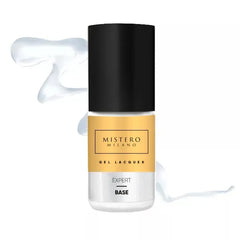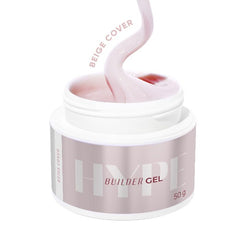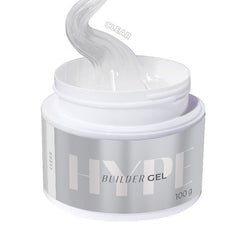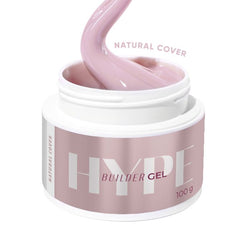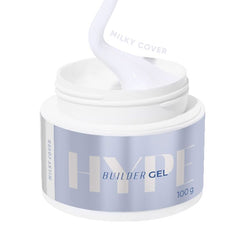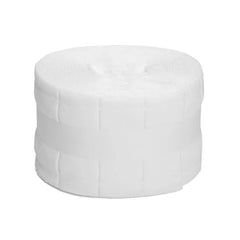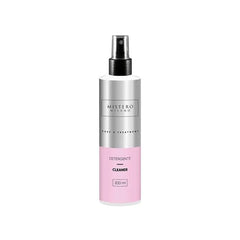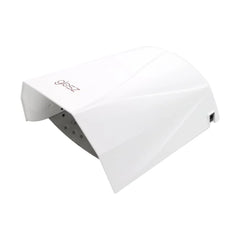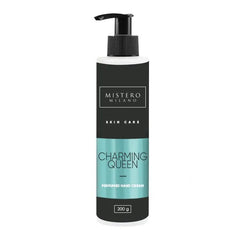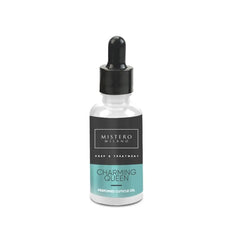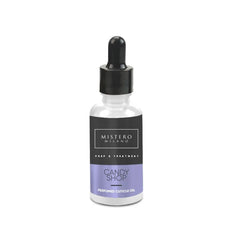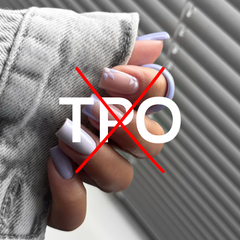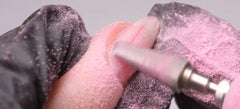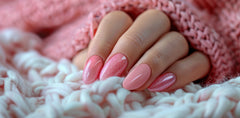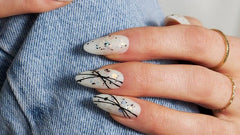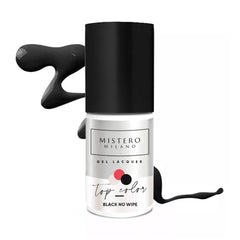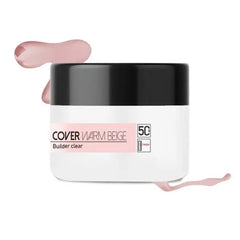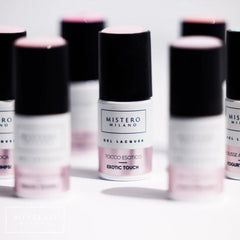Gel polish peeling – common problems
Amber D'Halluin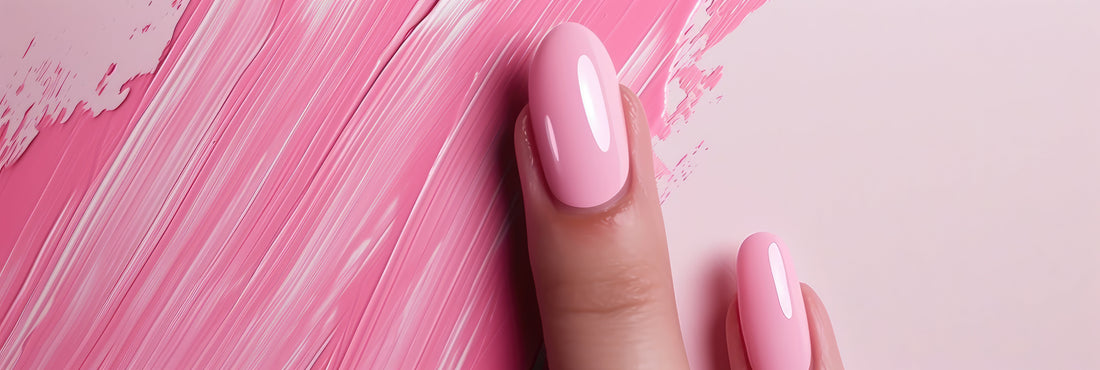
1. How can gel polish come off?
Did your gel polish come off after just two days? There are several reasons why this could happen, including poor preparation, incomplete curing, a damaged nail plate… Luckily, there are ways to prevent this from happening! Below, we’ll delve deeper into the factors that influence peeling and give you practical tips to prevent it in the future.
1.1 Poor preparation of the natural nail plate
To ensure optimal adhesion, it is very important that your natural nail plate is prepared correctly for the next steps of a manicure. A buffer file is an indispensable item for this. By matting your nail surface, you improve the adhesion of the nail products. This is done by creating small scratches in your nail plate during buffering, which ensures that the adhesion surface for artificial products becomes larger. Matte your nail plate by filing in one direction and use a 240/240 buffer file for this.
After matting, it is important to clean your nail plate with a cellulose swab and cleaner. This ensures that no dust residue remains on your nail plate. Follow these steps and enjoy a manicure that lasts longer!
1.2 Damaged nail plate / nail plate problems
A healthy nail plate is the basis for a beautiful and durable gel polish manicure. Unfortunately, a damaged nail plate is a common cause of artificial products, such as gel polish, coming loose.
To prevent the gel polish from chipping, it is important to keep the nail plate in good condition.
1.2.1 Incorrect gel polish removal
A damaged nail plate causes nail products to adhere poorly or not at all. It is very important that you remove your artificial nails correctly to cause as little damage as possible to your natural nail plate.
There are three ways to remove artificial nails and it is important to choose the right method. You can remove the nails with a regular nail file, with a nail drill or by using the soak-off method. If you are not confident with your skills with a nail drill, we recommend removing the nails for 80% with a nail file. You can then use remover to remove the remaining nail product.
By removing your artificial nails correctly, you ensure that your nail plate remains healthy and intact. This allows nail products to adhere much better, and you can enjoy well-groomed nails for longer!
1.2.2 Thin or cracked nail plate
Gel polish peeling can be the result of an uneven, thin or cracked nail plate. However, a normal base coat not enough when your nail plate is in bad condition. If your nails also have natural irregularities, it is possible that air keeps getting under the gel polish. Fortunately, there is a solution! You can level your nail plate by means of a rubber base or a builder gel before applying other nail products. This will provide an even and strong base, preventing lifting.
Are you suffering from cracked or split nails? In this case, it is recommended not to apply artificial nails for a while, so that the nail plate has time to recover. If the crack is in the tips of your nails, you can carefully shorten your nails and build them up using a rubber base or builder gel.

1.2.3 Nail plate disorders n
Gel polish peeling can be the result of nail diseases. In certain nail diseases, the use of gel polish is not allowed. It is important to let the nail plate heal before you continue with the application of gel polish. In addition, it is recommended to contact a dermatologist / doctor to receive the right treatment method for your specific condition. This way you can ensure that your nails remain healthy and strong.
1.2.4 Deformed nail plate
Perfectly caring for nail abnormalities such as hawk nails and deformed nail plates is a challenge for many of us. Covering with just a base coat, gel polish color and top coat is unfortunately not enough. For a long-lasting manicure of this type of nails, it is important to rebuild them and correct the architecture with builder gel.
1.3 Oily nail plate
A perfect gel polish manicure requires thorough preparation of your nail plate. The ungreased surface is one of the biggest challenges when applying gel polish and will cause rapid peeling. Fortunately, this is easily solved by degreasing your nail plate with a cellulose swab and cleaner .
However, it is not recommended to use products such as hand cream and cuticle oil while applying gel polish. These products can make your nails greasy again and prevent the gel polish from adhering. So keep your nails clean and degrease your nails before applying gel polish for the best results.
When preparing your nails for a gel polish manicure, it is important to remember that a degreased nail plate is the key to a long-lasting and beautiful manicure. So, make sure you prepare thoroughly and enjoy a radiant manicure for three weeks.
1.4 Gel polish layers that are too thick
It is very annoying to discover that the gel polish on your nails wrinkles after curing under a nail lamp. However, it is a common problem and fortunately easy to solve.
The cause of wrinkles is often due to applying too thick layers of nail product. It is important to know that the chance of wrinkles in gel polish is greater with highly pigmented colors than with regular light colors. So if you are planning to paint your nail in a striking color, be careful when applying the product. It is always better to apply two thin layers instead of one thick layer. This will prevent your nails from looking uneven and you can enjoy perfectly painted nails for longer.

1.5 Suddenly a gel polish allergy
One of the possible causes of loosening is a contact allergy. A contact allergy is an allergic reaction to certain ingredients that are processed in nail products.
There are a number of reasons why a contact allergy can occur. For example, by performing a manicure poorly, by prolonged or repeated skin contact or by working with poor quality products. Below we discuss the most common causes of an allergy to artificial nails:
- Damaged Cuticles and Nails: If your cuticles and nails are damaged, your body is directly exposed to uncured artificial nail mass.
- Poorly cured nail products: This can happen if the wrong lamp is used or if the curing times are not respected.
- Poor quality products: Using poor quality products can also lead to contact allergy.
- Unhygienic working practices: unhygienic working practices are an important cause of contact allergies, both for the nail stylist (e.g. by using a dirty brush) and for the client (e.g. by unwanted skin contact with spilled nail products).
It is therefore very important to pay attention to these factors when applying nail products. This will not only prevent annoying allergies, but you can also enjoy beautiful, healthy nails!
1.6 Gel polish runs
One of the reasons why gel polish peels off is due to the consistency of the product. This is a common problem with low-quality gel polish brands. Professional gel polish has a medium-thick consistency that prevents the nail product from running into the cuticles. This is an important aspect to consider when choosing gel polish.
Another reason why gel polish can come off is by applying too thick layers. It is better to apply thinner layers (brushing layers). This prevents the product from running into the cuticles and nail folds.

1.7 Gel polish breaks off
When applying nail products it is important to ensure that the tips of your nails are well sealed and to avoid painting too close to the cuticles. This prevents air from getting under the artificial nails, which can lead to breakage.
1.8 Gel polish sticks
It is important to know that time plays an important role in applying gel polish. It is necessary to respect the curing time indicated by the manufacturer. Curing too quickly can cause the entire manicure to come off. In addition, it is important to check whether the top coat you are using has a no wipe label or not. If your top coat does not have a no wipe label, you must take into account that a sticky layer remains after curing. You can easily remove this sticky layer by using a cellulose swab and cleaner.
1.9 Gel polish does not dry under the nail lamp
There are a number of aspects that can negatively affect the curing of nail products. These aspects include incorrect curing time, a weak or worn nail lamp or an incorrect position of the hand during curing. In the following paragraphs we will explain which factors affect curing and can lead to detachment.
1.9.1 Incorrect curing times
Curing your nail products is an important aspect to consider when creating a manicure that not only looks great, but also lasts a long time. It is important to respect the curing time indicated by the manufacturer. Curing too short can lead to a reduced durability of your manicure. Curing too long can result in cracked artificial nails that lose their elasticity. Make sure to respect the curing instructions to ensure that your nails not only look great, but also last longer!
1.9.2 Nail lamp too weak or worn out
The power of the nail lamp is an important factor in curing nail products. A nail lamp with a lower power or a lamp that is not in optimal condition will take longer to fully cure the gel polish. As a result, the curing period will take longer than with a lamp with a higher power. If the nail products are not sufficiently cured, this can result in not only lifting, but also in the development of a contact allergy. It is therefore important to use a nail lamp with sufficient power to achieve the desired result.
1.9.3 Wrong position in the lamp
A common mistake when curing nail products is incorrect hand positioning in the nail lamp. It is very important to make sure that your fingers are always flat and centered under the lamp. This will ensure that the nail products are cured properly.
1.10 Gel polish is peeling off at the nail tips
It is very important not to file your nails after they have been sealed. If you still want to file the nail into shape, you will remove the sealing and all your work will have been for nothing. You will create poorly adhering layers or air will get under the nails, which will almost certainly cause loosening. So make sure that your nail is already filed into the correct shape during preparation. 
1.11 Using bad gel polish
A common cause of peeling is using bad gel polish. To prevent peeling and keep your nails looking perfect, keep the following tips in mind.
- Check the expiration date: make sure your gel polish is not expired. An expired gel polish can lose its properties and lead to peeling faster.
- Store your gel polish properly: poorly stored gel polish can also lead to peeling. Make sure you always close your gel polish jar properly and store it in the right way and at the right temperature. The ideal temperature for storing gel polish is between 10 and 23°C. This will prevent your gel polish from drying out or becoming thick and sticky.
- Choose one brand: It is important to choose one gel polish brand. If you use products from different manufacturers or poor quality products, they may not work well together and you will not be sure if they will provide good adhesion and durability.
By following these tips, you can ensure that your gel polish is always of good quality and prevent peeling.
2. Can my gel polish come off due to hormonal problems?
Gel polish coming off is not only a result of incorrect manicure treatment, but also of hormonal factors. Pregnancy, stopping contraception or other hormonal changes can affect the nail plate. This can make your nail plate drier, more porous, more brittle or even more greasy.
But these hormonal changes can also have a positive effect on the adhesion of nail products. For example, a change in hormones can dry out a client’s oily nail plate, allowing gel polish to adhere better. On the other hand, if hormonal changes cause nails to become oilier, a client may experience issues with lifting.
Hormones control so many processes in our body, so changes in them can also affect the cells in our fingernails and affect the adhesion of gel polish. This can lead to lifting, loosening and adhesion, which is notable for nail technicians.
2.1 Is it true that medication causes my gel polish to come off?
Medication that you take for a month or two or daily medications “like birth control” will not affect loosening or lifting. However, people who have to take medication for a long time probably have an underlying condition. In this situation, it is likely the condition that is affecting the nails, not the medication itself.
Antibiotics used for a short period of time will most likely not have a negative effect on your nails. There are few medications that can quickly have a negative effect on the quality of your nails. One of the treatments and medications that does affect your nails is chemotherapy.

3. Wrong product choice
Choosing the right products is the most important thing when applying artificial nails. Using the wrong products can lead to problems such as lifting and loosening.
When choosing a primer it is important to start with anacid free one. This is less aggressive to your nails than anacid primer . If you find that you are using a acid free primer If you are still experiencing lifting or loosening, you can switch to a acidic primer. This will dry out the nail plate a little more to improve adhesion.
When choosing a base coat it is important to consider the type of nail plate. There are three different types of nail plates: normal, dry and moist.
- Normal nail plate: the skin does not shine, has a smooth surface and is not cracked or flaked. With a normal nail plate it is recommended to choose the Mineral Base , Expert Base or a Rubber Base .
- Dry nail plate: the skin looks flaky, the nail that grows under the surface of the gel tends to curl. In addition, a lot of dust is created when working with a milling cutter. With a dry nail plate, it is advisable to choose the 2in1 Base Coat .
- Moist nail plate: The skin is characterized by a natural high shine, moisture of the nail plate and moist fingertips. The nails of people with moist skin are very flexible. In case of a moist nail plate it is advisable to choose the Flexi Base .
In general, it is important to follow these guidelines when choosing the right products for your nails. This will help prevent lifting and ensure optimal adhesion.
4. Aftercare of the artificial nails
When you have had artificial nails applied, it is extremely important to take good care of your cuticles and hands. This prevents them from drying out, which can cause the artificial nails to come loose prematurely. After a manicure treatment, it is therefore advisable to regularly hand cream and cuticle oil to apply, to ensure that your nails and hands remain healthy and supple. By providing the right care to your artificial nails and hands, you extend the life of your manicure treatment and you can continue to enjoy beautiful nails!

